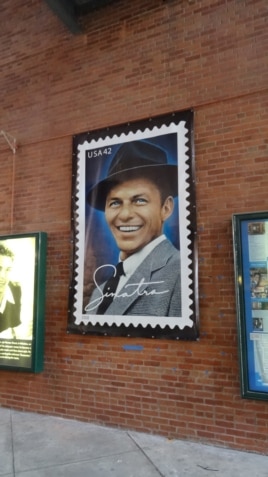
Frank Sinatra 1959 «Come Dance With Me» Capitol Records ?? 1978 Sid Avery
Frank Sinatra Remembered in Small Hometown
HOBOKEN, NEW JERSEY—Before singer Frank Sinatra became a global household name, he was a local boy from a small New Jersey town across the river from Manhattan.
In that town — Hoboken — a street is named after him, and to celebrate Sinatra’s 100th birthday anniversary, Hoboken’s museum has him on proud display.
Robert Foster, Executive Director of the Hoboken Historical Museum, said fans visit from as far away as Brazil and France who used to listen to Sinatra on the radio when they were growing up.
“They always love the message of his music, they always felt connected to his voice,” he said.
A part of the exhibit is dedicated to Sinatra’s fans. In the times predating the Internet and social media, Sinatra admirers wrote letters to each other and to the singer, and even dedicated poems to him. They did not care that Sinatra never graduated from high school, that he lacked a music education, and could not read music.
An immigrant story
Sinatra’s velvety baritone brought him glamour and fame in New York and Hollywood, where he won numerous Grammys and an Oscar. His success is an immigrant story.
“He was growing up Italian at a time when Italians were still new to this country,” said Forster. “So, he would talk about discrimination against Italians.”
Sinatra spent his first 21 years in Hoboken in an Italian neighborhood. He sang in bars and played the ukulele.
His former house, at 415 Monroe Street, burned to the ground during Sinatra’s lifetime, but his fans planted a star on the sidewalk in his honor.
Frank Palmisano, a relative of the family, now owns the parking lot where the Sinatras’ house used to stand. He remembers Frank’s parents, Dolly and Marty.
“I knew Dolly; I knew Marty. I used to bring the beer and soda to their house,” said Palmisano.“And then they moved to Fort Lee when he bought them the house.”
Local legend
Two other residents of Monroe Street call themselves Uncle Sal and Uncle Whitey. Uncle Whitey remembers one Sinatra story in particular.
“My cousin owned a restaurant, and he ate there one Sunday,” recalled Uncle Whitey. “He told my cousin: ‘Anytime I am in New York, you tell people I am here.’ Even though they knew he wasn’t there, that place was crowded for two weeks after he left. They would just stare at the seat.”
It is quite possible that Sinatra used to go to the river bank and look across at the lights of the big city. It may have even inspired him to record his famous version of New York’s most iconic tune.
“If I can make it there, I’m gonna make it anywhere, It’s up to you, New York, New York.”


